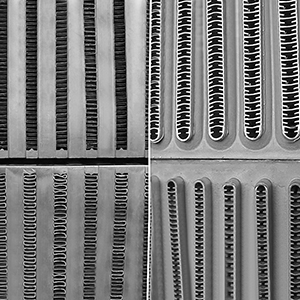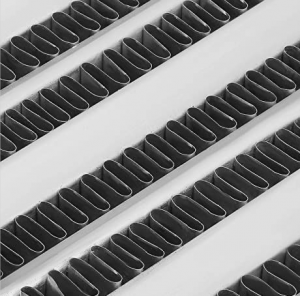Here's a question you've probably been asked a few times: "What's the best intercooler for my car?"
You probably know the answer: "A high-performance intercooler system is a must for any performance car!"
And you're right. But what makes a high-performance intercooler?
In this complete guide, we'll go in-depth on the different types of intercooler, the bar and plate vs the tube and fin intercooler.

What Is an Intercooler?
An intercooler is an intake air cooling device used commonly on turbocharged and supercharged engines. It is a component of an air-to-air induction system.
It is designed to reduce the charge air temperature from the engine into the engine's air intake.
Intercoolers use metal fins that the ambient air passes through to take heat away from the charged air.
Charged air passes through internal air galleries filled with tiny metal fins; these air galleries attach to many other small metal fins on the outside.
These metal fins take heat away from the internal air galleries when ambientair travels over them, cooling down the charged air.

Bar & Plate Intercooler
Bar and plate intercoolers have more rectangular air galleries, which allow a higher volume of compressed air to pass through the intercooler.
But because these galleries are not as aerodynamic, there is more resistance to airflow passing through the core.
A bar and plate intercooler is usually more robust and can withstand higher pressure than a tube and fin, but they are less efficient.
They are also heavier and usually have less of a pressure drop.


Tube & Fin Intercooler
Tube and fin intercoolers have curved-edged air galleries.
Because of these curved edges, they make the overall capacity less.
However, the tube and fin intercooler produce less resistance to the ambient air as it passes through the intercooler to cool the compressed air.
Tube and fin are usually more efficient and lighter, but they are not as strong.
Therefore, they can't take as high boost pressure as bar and plate intercoolers.
Pressure drop is also higher in tube and fin intercoolers.

Bar & Plate vs Tube & Fin Intercoolers
Bar and plate are denser cores from a build standpoint; they take longer to heat soak.
Some people see this as an advantage; the flip side is they also take much longer to cool down after heat soaking.
They do not flow air as well, making them inefficient.
They were never actually designed for automotive applications.
Some people prefer bar and plate intercoolers because they are sturdy, but they are also heavier.
Tube and fin, on the other hand, were always designed for automotive applications.
They flow air better, but they can heat soak faster, though they also cool down more quickly due to better cross flow.
In cars, tube and fin intercoolers are much more efficient.
Even more advanced tube and fin intercoolers are now on the market.
They are called square tube and fin and are in the middle ground between a bar and plate and original tube and fin designs.
They are more robust and lighter yet still have excellent crossflow.
Overall, tube and fin are more effective; however, they are not as robust as bar and plate intercoolers.
The cooling efficiency and air pressure loss of the intercooler mainly depend on the flow pipe and heat sink in the radiator core of the intercooler, so a high performance intercooler should have the following characteristics.
Tub—Taking thicker pipe diameters but thinner pipe walls. The thicker pipe diameter can reduce the resistance of air circulation, and the thin pipe wall can effectively improve the heat dissipation capacity.
So,which one you choose really comes down to what kind of budget you are looking to spend on your project and what kind of power you're making ,what kind of boost levels you're running the size turbocharger you're using. And these all factors we're going to talk about in a future.
Post time: Sep-30-2022